Introduction
Problem Statement
- In this busy world, people forget to buy home essentials like sugar, salt, chilly powder, etc. They don't remember the expiry dates of the food items in the kitchen, which tends to spoilage of food items. Sometimes, people accidentally use these expired food items, leading to health problems. And also measuring the ingredients like 1 tablespoon, 1 teaspoon, etc. while cooking is time-consuming, it wastes our time.
- Blind people are facing difficulties while cooking, like finding particular food items in the kitchen, adding the exact amount of ingredients, etc.
- In hospitals (especially in homeopathy), pharmacists face difficulty finding particular medicine containers from racks of containers for preparing homeo medicines. And also sometimes they forget the expiry periods of the medicines, which will affect the life of the patients.
- In laboratories and industries also it is difficult to find a particular salt or chemical container from a large group of salt or chemical containers. And also measuring the exact amount of salts or chemicals using a pipette, burette, spoon, etc. are time-consuming and risky. Sometimes human errors will occur while measuring.
Solution
- Multipurpose Intelligent Canister is a special type of smart container, the technologically advanced version of today’s container that can be used in kitchens, hospitals, laboratories, etc.
- These canister is capable of tracking the expiry and exact amount of commodity stored inside it and alerting the user when it gets expired or depleted below a certain level via a smartphone using IoT.
- It can recognize voice commands from the user and can perform different functions such as dispensing the exact amount of commodity as instructed by the user.
- Standing out itself from a group of containers when its name is called by using a LED indicator. For example, if we say ‘chilly powder,' the container having chilly powder glows up the LED indicator.
- The LED indicator provided on the top of the canister gives the visual indications of different functions according to the voice commands.
- The canister can be trained in any language.
- It also supports Google Assistant and Alexa.
- It can be wirelessly charged from its dock.
3D Sketch
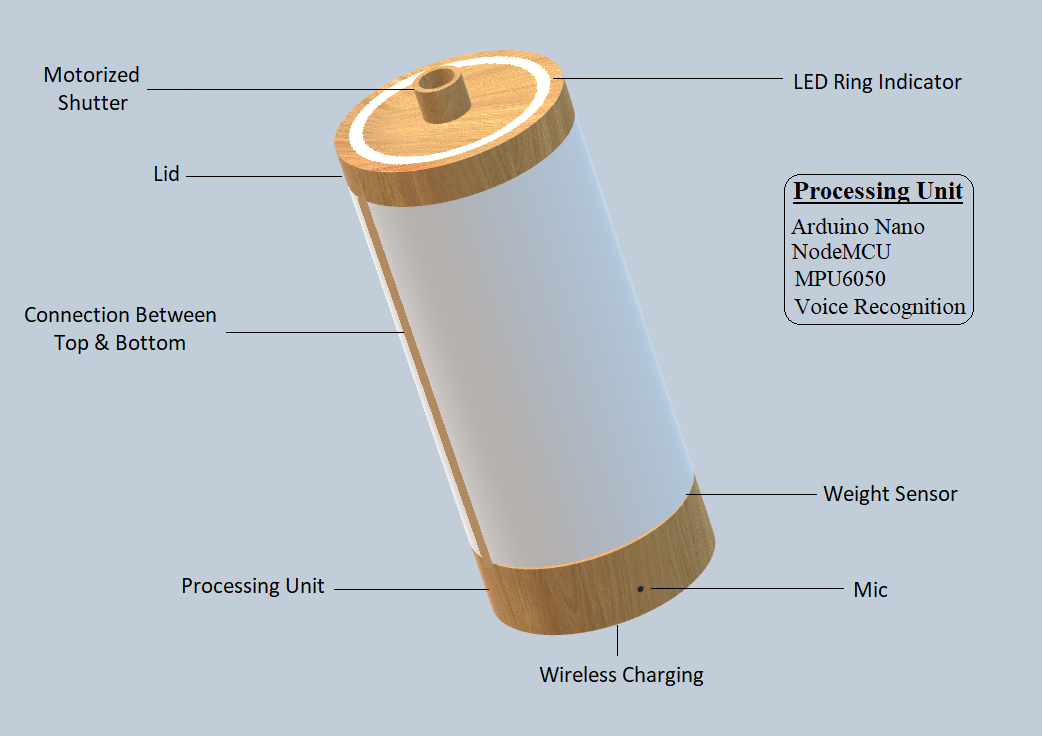
Block Diagram
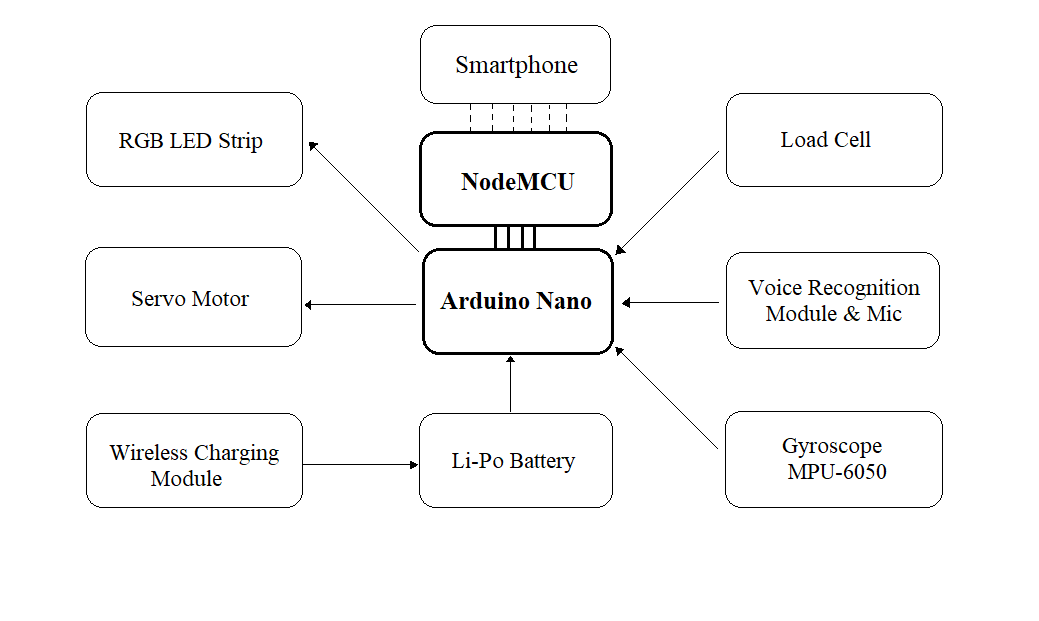
- Multipurpose Intelligent Canister uses Arduino Nano which is the brain of the canister.
- Arduino Nano processes signals from the Load cell, Voice recognition module, and Gyroscope and controls the RGB LED strip and Servo motor accordingly.
- The Arduino Nano sends and receives data from NodeMCU ESP8266 which enables IoT functionality.
- The NodeMCU can be connected to a smartphone via the internet. so, that we get the notifications regarding the commodities stored inside it according to the data obtained from different modules.
- The Load cell is a force transducer that is used to measure the exact amount of commodity stored inside it.
- Voice recognition module recognizes the voice commands from the user and checks them with the pretrained voice commands and sends data to the Arduino Nano.
- Gyroscope sends the data regarding the orientations of the container for calculating the time required for the shutter activation, for dispensing the exact amount of commodity.
- Servo motor is used for opening and closing the shutter according to the data obtained from different modules.
- RGB LED strip (NeoPixel ring 16) provides visual alerts using different colors for different functions according to the voice commands.
- All the components are powered by a Li-Po battery.
- The battery can be charged wirelessly when it is placed in its dock by using wireless charging modules.
Circuit Diagram
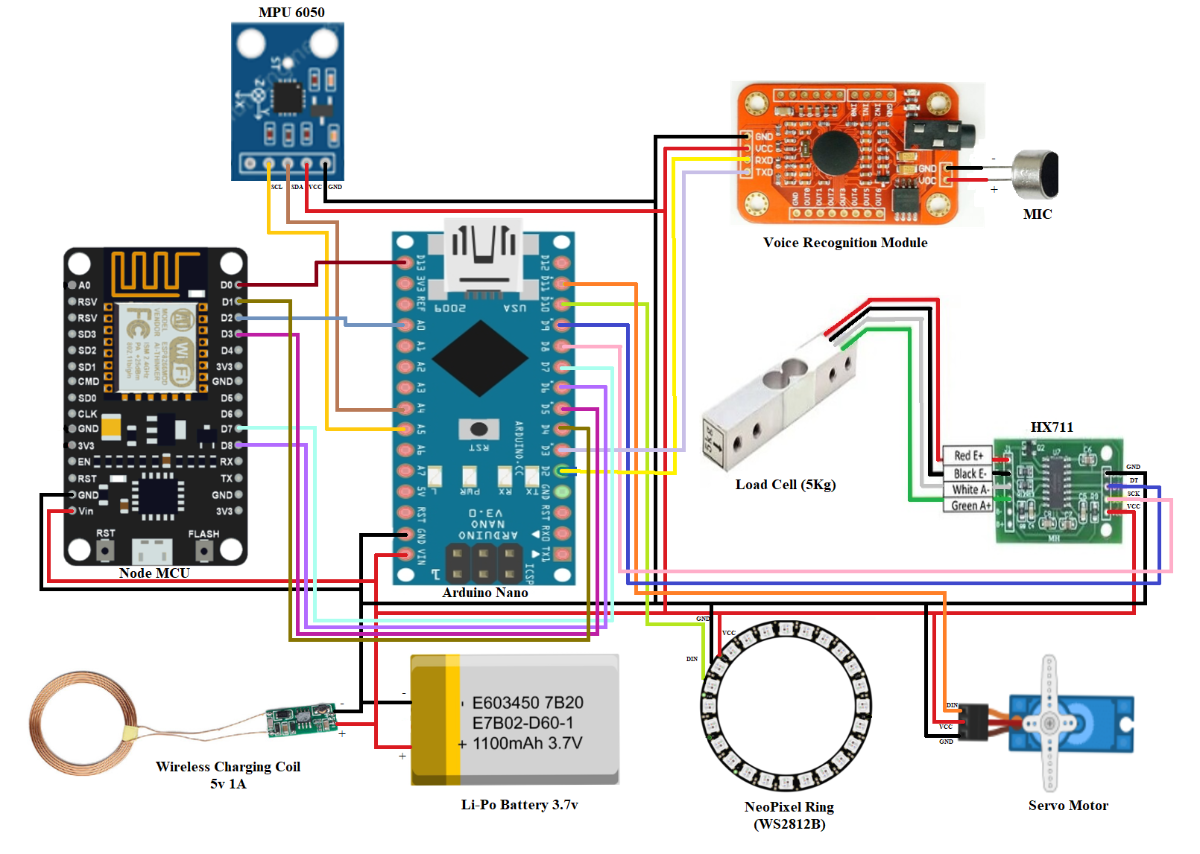
- The circuit consists of Arduino Nano, NodeMCU, 5kg Load cell, HX711 driver, MPU6050, Servo motor, NeoPixel ring, Voice recognition module, condenser microphone, Li-Po battery (3.7V), and a wireless charging module (5V, 1A).
- The Voice recognition module, Load cell, and MPU6050 are the inputs to the Arduino Nano. Servo motor and NeoPixel ring are the outputs of the Arduino Nano.
- The Arduino Nano communicates with NodeMCU via 6 digital pins.
NodeMCU Arduino Nano
D0 D13
D1 D4
D2 A0
D3 D5
D7 D7
D8 D6
- NodeMCU sends and receives data from the smartphone via the internet.
- By using Blynk App we can receive notifications of the commodity stored inside the canister and also we can control the canister through the smartphone.
- In this project, I have used a strain gauge type 5 KG Load cell. It measures the exact amount of commodity stored inside the canister.
- The electrical output from the Load cell is very feeble. So we use the HX711 driver to interface the Load cell to the Arduino Nano. The HX711 is a 24bit ADC, which amplifies and digitally converts the Load cell output.
- The HX711 driver is connected to the GPIO pins D8 and D9 of the Arduino Nano.
- The Voice recognition module V3 is a speaker-dependent voice recognition module. It supports up to 80 voice commands in all.
- Maximum 7 voice commands could work at the same time. Any sound could be trained as a command. Users need to train the module first before letting it recognize any voice command.
- A condenser microphone is connected to this module for receiving voice commands from the user.
- The Voice recognition module is connected to the GPIO pins D2 and D3 of Arduino Nano.
- The MPU6050 is a three-axis accelerometer and three-axis gyroscope that is used to measure the velocity, orientation, acceleration, and displacement of the canister.
- It has Digital Motion Processor (DMP), which has the property to solve complex calculations.
- This module uses the I2C module for interfacing with microcontrollers. It is connected to the GPIO pins A4 and A5 (I2C port) of Arduino Nano.
- The Servo motor is used for the opening and closing of the shutter provided on top of the canister, through which the commodity inside it is dispensed.
- The Servo motor is controlled using PWM signals. It is connected to the GPIO pin D11 (PWM pin) of the Arduino Nano.
- The actuation of the Servo motor is controlled by the Arduino Nano, and it depends on the input signals obtained from the MPU6050, the Load cell, and the Voice recognition module.
- The NeoPixel ring is an RGB LED strip that provides visual notifications.
- The NeoPixel ring consists of 16 individually addressable RGB LEDs that can all be controlled with a single digital output of a microcontroller and chained together with other rings. This is achieved by the WS2812 driver integrated into each RGB LEDs.
- The NeoPixel ring is connected to the GPIO pin D10 of the Arduino Nano. It lights up in different colors and patterns in accordance with signals received from different modules.
- The Li-Po battery acts as the source for the entire circuit of the canister. It’s a 3.7V 1100mAh battery that is wirelessly charged using a 5V 1A wireless charging module.
- The wireless charging module consists of a transmitter coil and a voltage regulator as well as a receiver coil and a 5V 1A voltage regulator.
Flow Chart
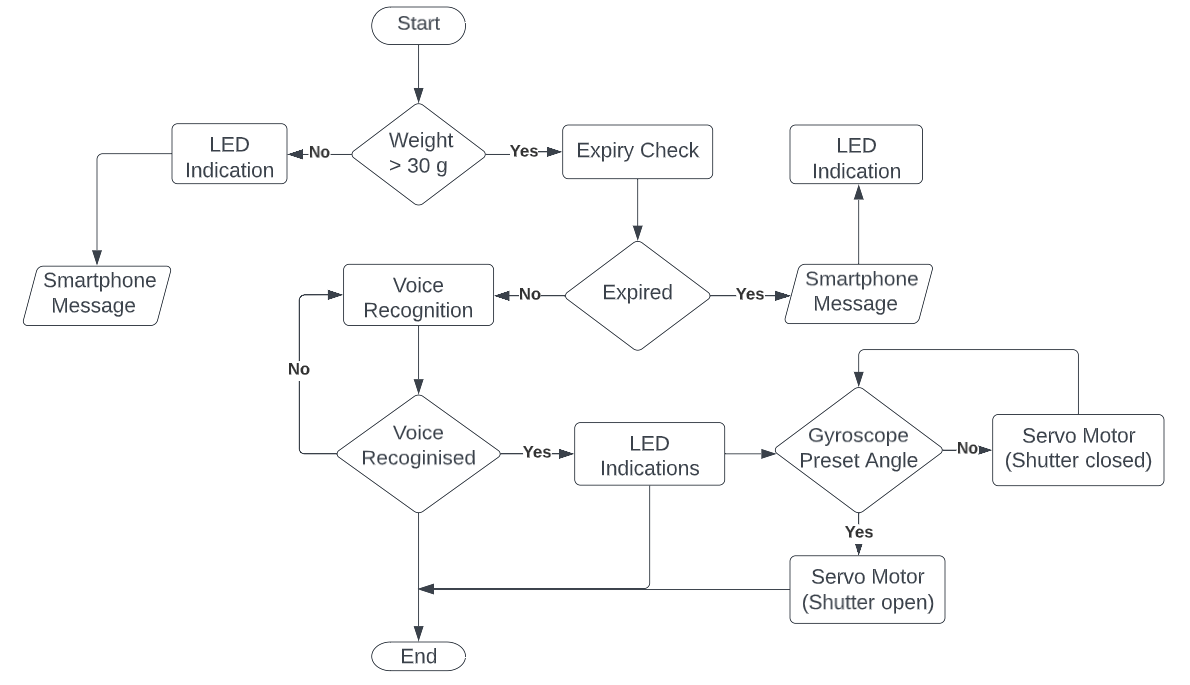
- The first iteration is the calibrations, the canister calibrates the load cell constant and orientation of the canister.
- On the next iteration the canister first checks the weight of the commodity inside the canister. If the weight is less than 30 grams the LED indicator turns on and a notification is sent to the smartphone.
- If the weight is greater than 30 grams, then the canister checks for the expiry of the commodity. The expiry period is set before using the canister. The expiry alert is given by the expiry counter in the program. If the expiry counter is greater than the preset expiry period, the canister alerts the user through the LED indicator and a smartphone notification.
- If the expiry counter is less than the preset expiry period, then the canister ready for receiving voice commands.
- If the voice recognized matches the pretrained voice the LED indicator glows up in different colors and patterns according to the voice commands and ends the iteration.
- If the voice command is for dispensing the commodity, then first the LED indicator glows up, and the gyroscope check for the tilt angle of the canister. If the tilt angle is greater than the preset angle the servo motor activates and the shutter is opened for dispensing the commodity and the iteration ends.
- If the tilt angle is less than the preset angle, then the servo motor is activated to close the shutter and wait for the preset angle to reach, to open the shutter.
- And all these steps repeats except step 1.
Blynk App Interface
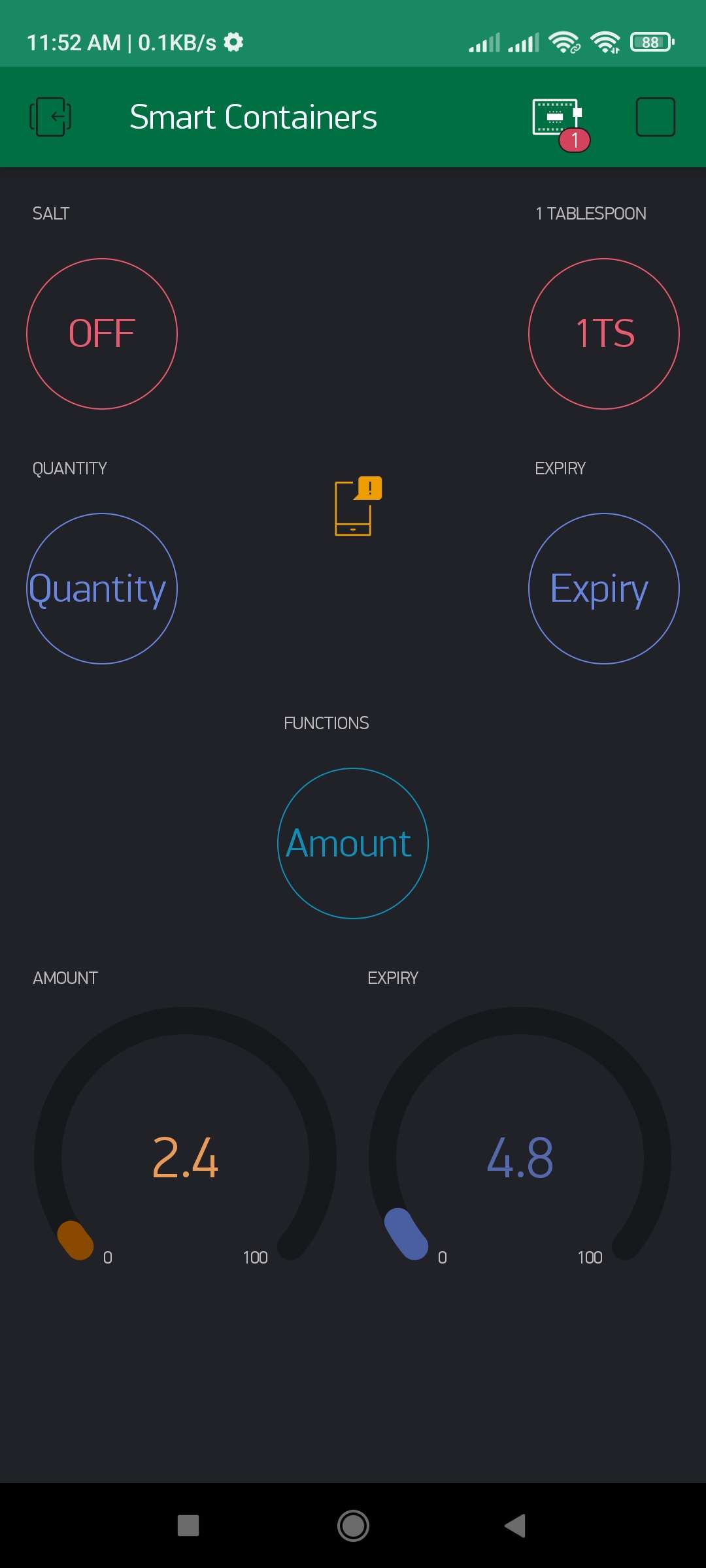
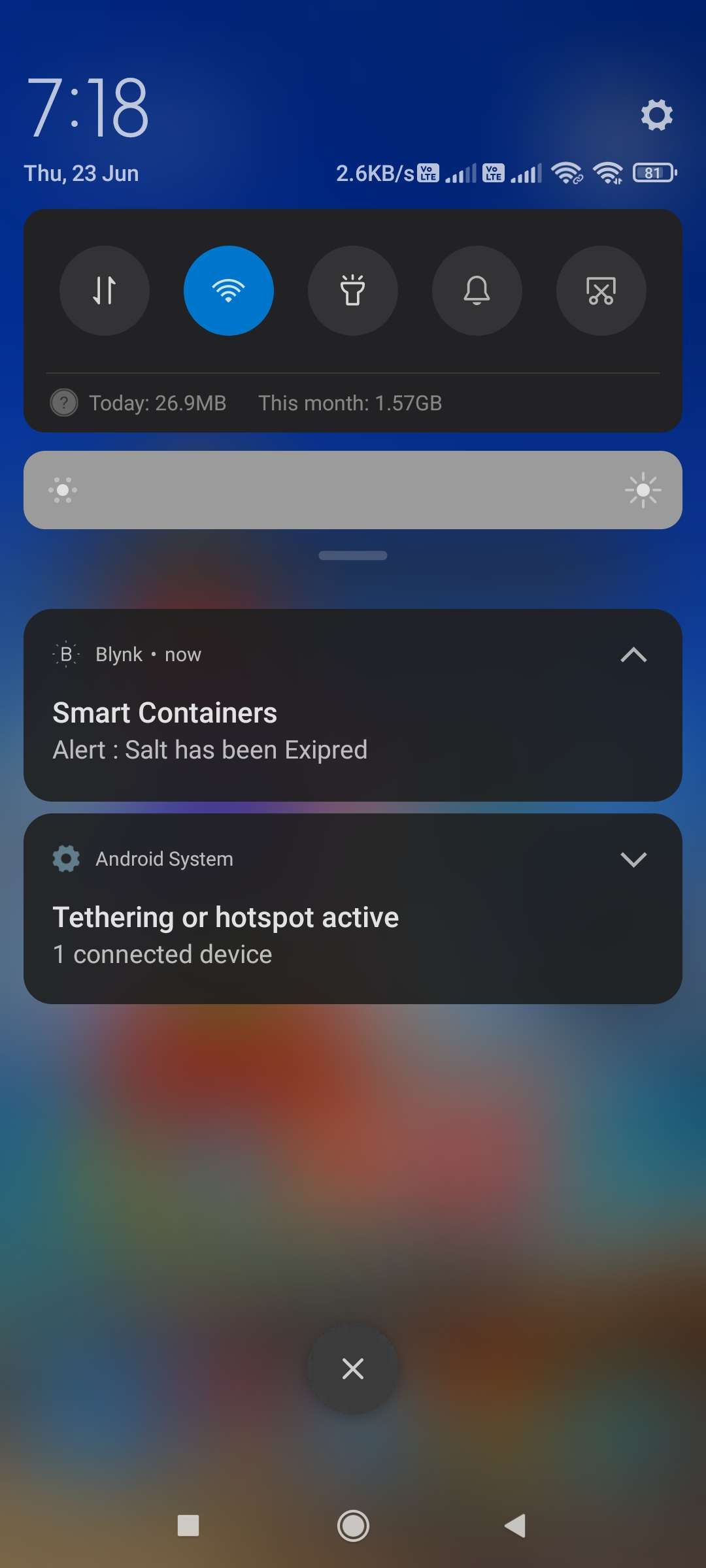
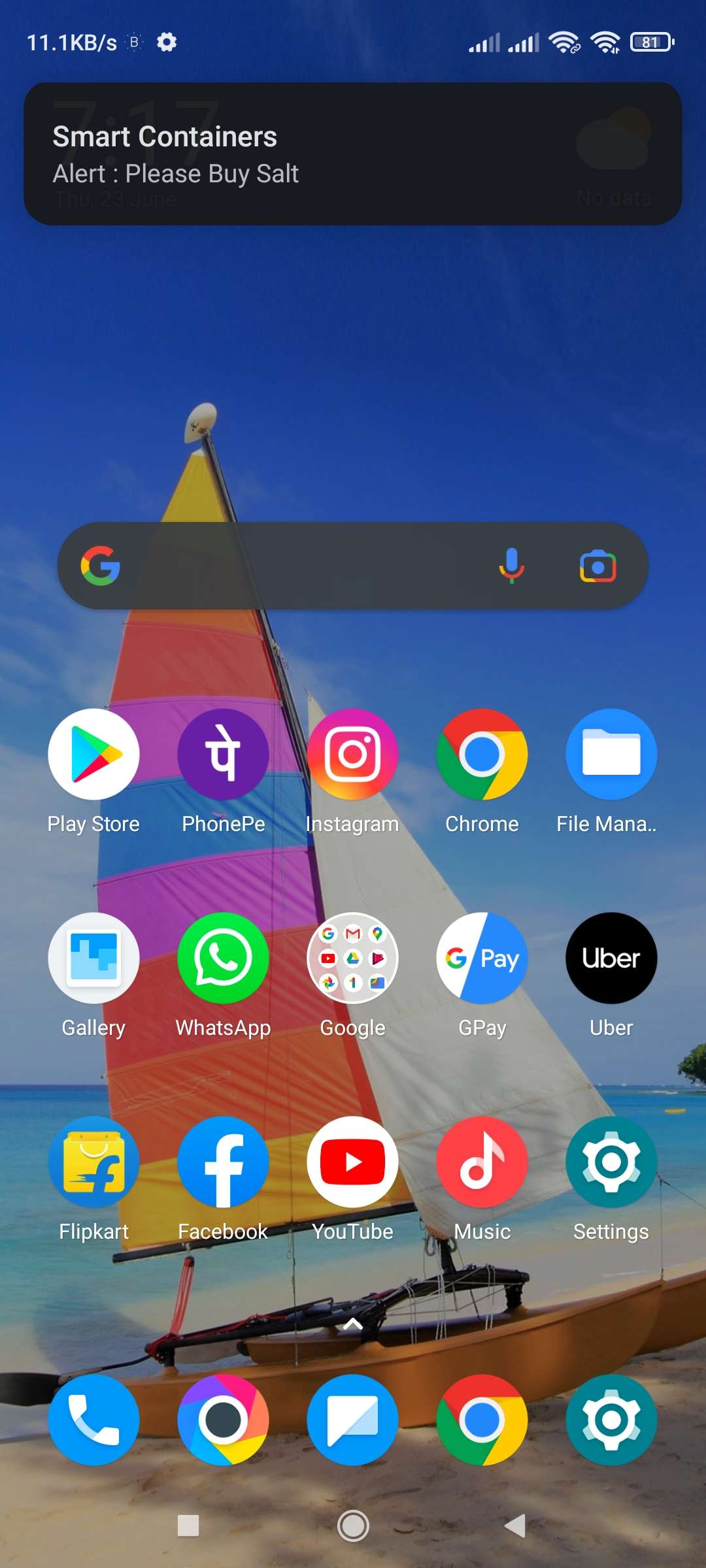
Applications
- It can be used in hospitals, especially in homeopathy where pills are made by mixing powdered or liquid medicines. It helps the pharmacist to find out the medicine easily from a rack of containers by just saying the name of the medicine with the help of an LED indicator and also getting the exact amount of medicine through voice commands.
- By adding a speaker and a vibrator these canisters will be helpful for blinds while cooking.
- It can be used in the kitchen for storing food items and it reduces food spoilage by alerting the user regularly. Hence food wastage can be reduced, also money and time can be saved.
- It can be used in laboratories and industries for storing chemicals and by replacing the motorized shutter with MEMS-based micro precision valves we can replace pipettes and burettes in laboratories.
- It can be used in hotels for dispensing the exact amount of ingredients while cooking.
Future Development
Replacing all the containers in our kitchen with Multipurpose Intelligent Canisters and with the help of an AI-based smartphone App, we can know what all dishes can be made using the available food items in our kitchen and serving quantity. Also, it can purchase the food item automatically through online merchants when the level of the food item is low or expired. It will be helpful for beginners in cooking. If we select a dish and its serving quantity, the canisters will glow up light according to the order of ingredients added and automatically dispense the exact amount of ingredients needed for the dish without any human intervention. These concepts can be also implemented in hospitals for preparing medicines and hence human errors in medicine preparation can be reduced.